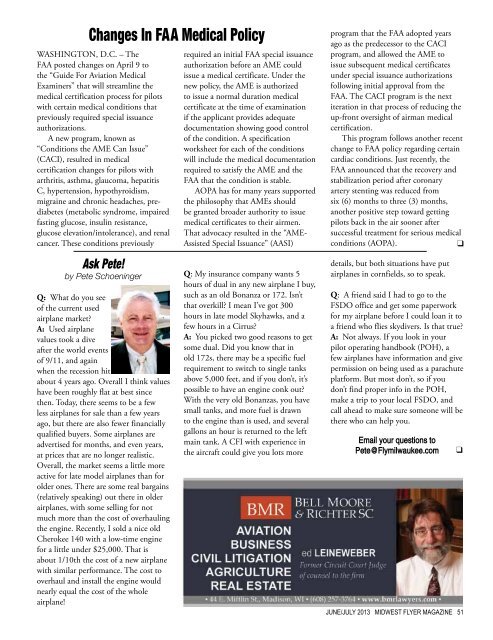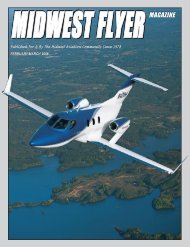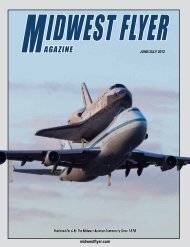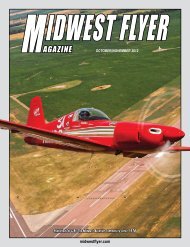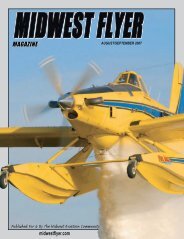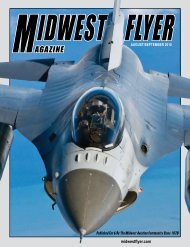Create successful ePaper yourself
Turn your PDF publications into a flip-book with our unique Google optimized e-Paper software.
Changes In FAA Medical Policy<br />
WASHINGTON, D.C. – The<br />
FAA posted changes on April 9 to<br />
the “Guide For Aviation Medical<br />
Examiners” that will streamline the<br />
medical certification process for pilots<br />
with certain medical conditions that<br />
previously required special issuance<br />
authorizations.<br />
A new program, known as<br />
“Conditions the AME Can Issue”<br />
(CACI), resulted in medical<br />
certification changes for pilots with<br />
arthritis, asthma, glaucoma, hepatitis<br />
C, hypertension, hypothyroidism,<br />
migraine and chronic headaches, prediabetes<br />
(metabolic syndrome, impaired<br />
fasting glucose, insulin resistance,<br />
glucose elevation/intolerance), and renal<br />
cancer. These conditions previously<br />
Ask Pete!<br />
by Pete Schoeninger<br />
Q: What do you see<br />
of the current used<br />
airplane market<br />
A: Used airplane<br />
values took a dive<br />
after the world events<br />
of 9/11, and again<br />
when the recession hit<br />
about 4 years ago. Overall I think values<br />
have been roughly flat at best since<br />
then. Today, there seems to be a few<br />
less airplanes for sale than a few years<br />
ago, but there are also fewer financially<br />
qualified buyers. Some airplanes are<br />
advertised for months, and even years,<br />
at prices that are no longer realistic.<br />
Overall, the market seems a little more<br />
active for late model airplanes than for<br />
older ones. There are some real bargains<br />
(relatively speaking) out there in older<br />
airplanes, with some selling for not<br />
much more than the cost of overhauling<br />
the engine. Recently, I sold a nice old<br />
Cherokee 140 with a low-time engine<br />
for a little under $25,000. That is<br />
about 1/10th the cost of a new airplane<br />
with similar performance. The cost to<br />
overhaul and install the engine would<br />
nearly equal the cost of the whole<br />
airplane!<br />
required an initial FAA special issuance<br />
authorization before an AME could<br />
issue a medical certificate. Under the<br />
new policy, the AME is authorized<br />
to issue a normal duration medical<br />
certificate at the time of examination<br />
if the applicant provides adequate<br />
documentation showing good control<br />
of the condition. A specification<br />
worksheet for each of the conditions<br />
will include the medical documentation<br />
required to satisfy the AME and the<br />
FAA that the condition is stable.<br />
AOPA has for many years supported<br />
the philosophy that AMEs should<br />
be granted broader authority to issue<br />
medical certificates to their airmen.<br />
That advocacy resulted in the “AME-<br />
Assisted Special Issuance” (AASI)<br />
Q: My insurance company wants 5<br />
hours of dual in any new airplane I buy,<br />
such as an old Bonanza or 172. Isn’t<br />
that overkill I mean I’ve got 300<br />
hours in late model Skyhawks, and a<br />
few hours in a Cirrus<br />
A: You picked two good reasons to get<br />
some dual. Did you know that in<br />
old 172s, there may be a specific fuel<br />
requirement to switch to single tanks<br />
above 5,000 feet, and if you don’t, it’s<br />
possible to have an engine conk out<br />
With the very old Bonanzas, you have<br />
small tanks, and more fuel is drawn<br />
to the engine than is used, and several<br />
gallons an hour is returned to the left<br />
main tank. A CFI with experience in<br />
the aircraft could give you lots more<br />
program that the FAA adopted years<br />
ago as the predecessor to the CACI<br />
program, and allowed the AME to<br />
issue subsequent medical certificates<br />
under special issuance authorizations<br />
following initial approval from the<br />
FAA. The CACI program is the next<br />
iteration in that process of reducing the<br />
up-front oversight of airman medical<br />
certification.<br />
This program follows another recent<br />
change to FAA policy regarding certain<br />
cardiac conditions. Just recently, the<br />
FAA announced that the recovery and<br />
stabilization period after coronary<br />
artery stenting was reduced from<br />
six (6) months to three (3) months,<br />
another positive step toward getting<br />
pilots back in the air sooner after<br />
successful treatment for serious medical<br />
conditions (AOPA).<br />
q<br />
details, but both situations have put<br />
airplanes in cornfields, so to speak.<br />
Q: A friend said I had to go to the<br />
FSDO office and get some paperwork<br />
for my airplane before I could loan it to<br />
a friend who flies skydivers. Is that true<br />
A: Not always. If you look in your<br />
pilot operating handbook (POH), a<br />
few airplanes have information and give<br />
permission on being used as a parachute<br />
platform. But most don’t, so if you<br />
don’t find proper info in the POH,<br />
make a trip to your local FSDO, and<br />
call ahead to make sure someone will be<br />
there who can help you.<br />
Email your questions to<br />
Pete@Flymilwaukee.com<br />
q<br />
JUNE/JULY 2013 MIDWEST FLYER MAGAZINE 51


